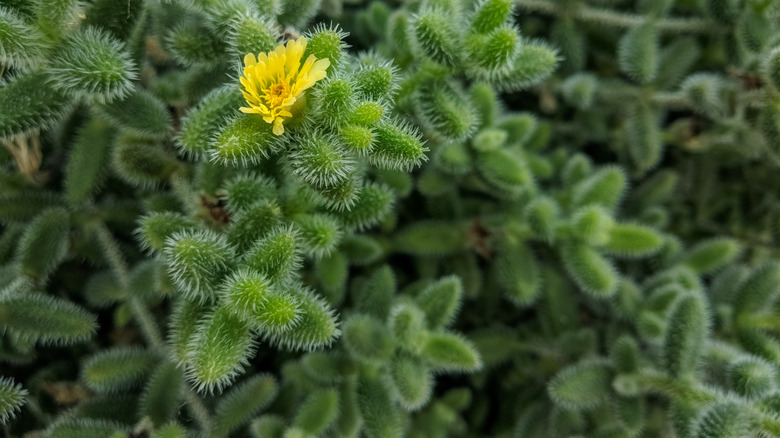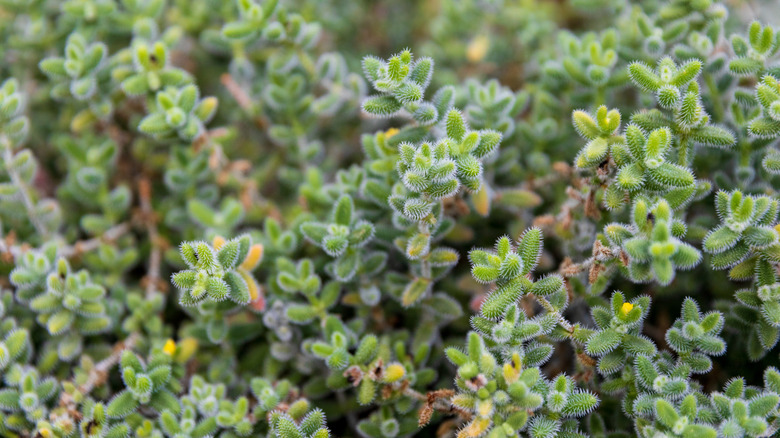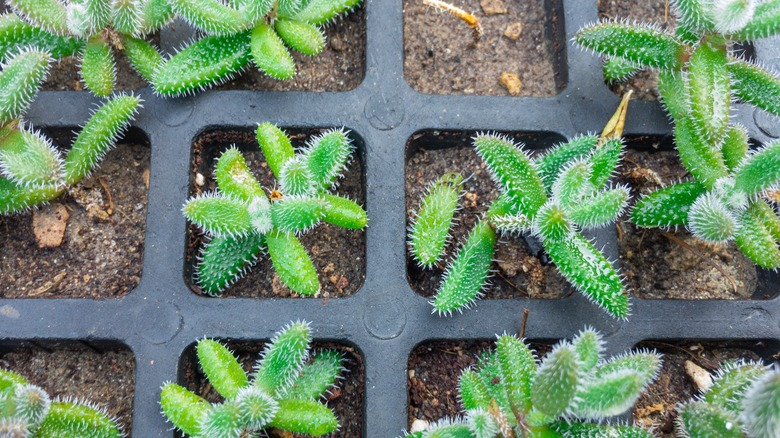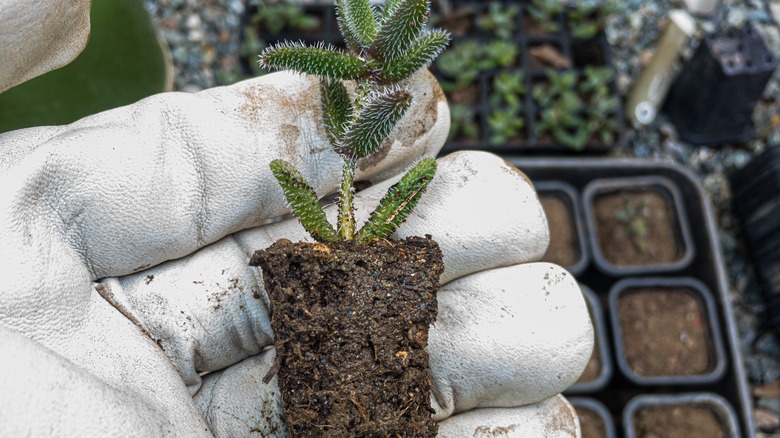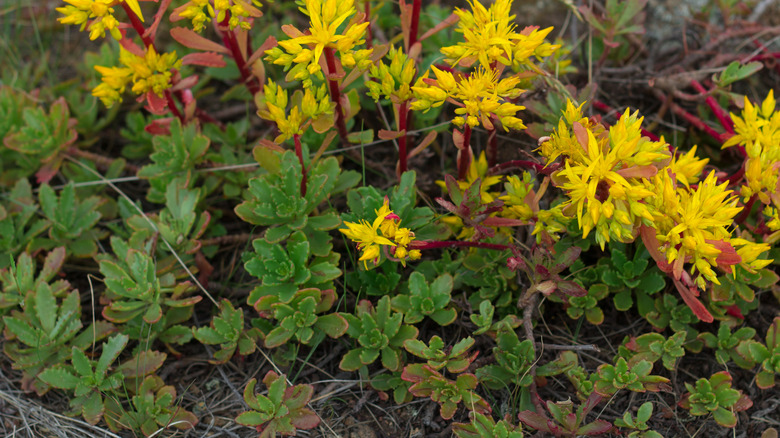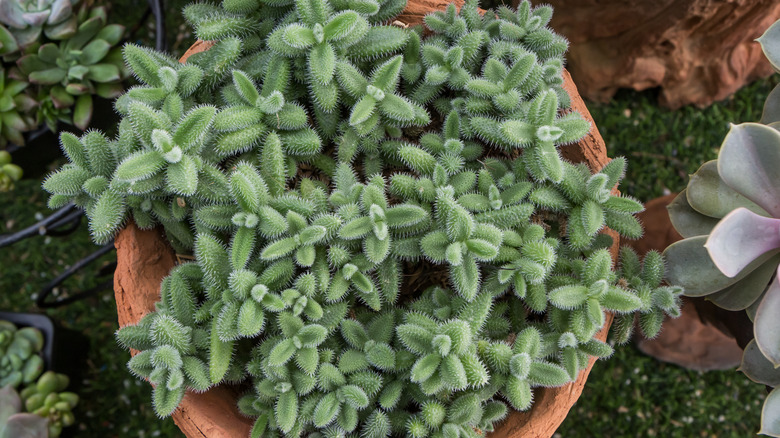How To Care For A Pickle Plant Succulent
If you're looking for an easy-to-care-for plant to add to your collection, then Delosperma echinatum, commonly known as the pickle plant, is a great option. This shrubby succulent grows long stems and features small, prickly green leaves in pairs. In the wild, you may find these growing stretched out on the ground, but they can also grow upwards about 18 inches.
Similar to other succulents, pickle plants are easy to care for both inside and outside the home. Once the plant has been established, as is the case for most mature houseplants, the pickle plant can be very drought tolerant. This makes it a great option for beginner plant enthusiasts as well as seasoned plant collectors. According to World of Succulents, the pickle plant species is native to South Africa, where it grows as ground cover throughout the coastal Eastern Cape region.
Delosperma echinatum is incredibly easy to propagate, which means you can double the number of pickle plants in only a few months. So if a lush green home or garden is your goal, the pickle plant should be a must-have.
How to use pickle plant succulent in garden
Pickle plants make a great addition to your garden as ground cover. But before you plant them outside, you'll want to check which hardiness zone you live in. Pickle plants prefer warm climates and grow best in USDA Zone 10b, according to Succulents Network. But this succulent will also grow well anywhere between Zone 7a to 10b. They're more tolerant to cold temperatures than other succulents, but a hard frost will kill the plant.
Zone 10b is a warm climate, with low temperatures between 35 and 40 degrees Fahrenheit. In America, this USDA Zone encompasses South Florida. Most of the Southern United States, South West, and Southern California are also included in the zones where the pickle plant will thrive outdoors. The northern parts of Zone 7a include Long Island, New York, and coastal New Jersey, per Wilson Bros Gardens. Outside of these areas, it's best to plan Delosperma echinatum indoors.
How to grow pickle plants
If you're familiar with growing succulents, growing pickle plants will be a breeze. With the right care, these succulents will have white or yellow flowers in the spring. You'll be able to grow pickle plants inside in a pot or outside in your garden.
Pickle plants aren't finicky or picky, so you don't have to find any special soil for them to grow in. But for your pickle plant to thrive, you could plant them in a mix of succulent soil and perlite or coarse sand, per Gardening Calendar. This will create well-draining soil so your plant doesn't sit in moisture. A succulent soil will also provide your plant with the nutrients needed to grow healthy.
As for tools, your typical gardening gear like gloves, a gardening trowel, a cultivator, and a transplanting trowel. Must-have succulent tools, according to Succulent City, include pruning shears for propagating, curved tweezers to remove pests or dead leaves, and small artist's brushes to clear away any dirt. A water meter to measure the moisture level in your soil will also be beneficial.
Propagating a pickle plant is quite easy. Cut a stem about 2.5 to 3 inches long. Remove the bottom leaves and allow the cutting to dry and callous over two days. Once the cutting it dry, you can replant it into well-draining soil. After 4 to 6 weeks, your propagation should put out a new stem. You can repeat this process as many times as you want.
How to care for pickle plants
Like many other succulents, pickle plants are easy to take care of. The basic care for pickle plants is lots of sunlight and a little water.
Bright to bright indirect light will help your pickle plants thrive. Outside, plant Delosperma echinatum where it'll get a lot of sunlight. Avoid growing these plants in shaded areas. Inside, a window facing west or south will give these plants the best sunlight. Be sure to keep pickle plants away from drafty windows or cold areas in your home.
Pickle plants don't need much water, and they will easily die when overwatered. Instead of watering on a set schedule, you'll want to fully soak the soil and allow it to fully dry before watering again. Because succulents don't like water on their leaves, you can try bottom watering, per Succulent and Sunshine. To do this, fill a bowl with water and place the pot inside the water. Allow it to sit until the top of the soil feels wet. Remove the pot and place it back in the sunlight. Use a water meter to measure how damp the soil is before watering again. During the warmer months–the pickle plant's active growing season, you'll have to water your plant more often. In colder months, reduce your watering schedule because your plant is likely dormant. According to Gardening Calendar, when the leaves get droopy and soft, that's your pickle plant's way of telling you it needs some water.
Pickle plant varieties
While there aren't other varieties of pickle plants, they belong to the Aizoaceae family of succulents and the Delosperma genus sub-category, according to Live to Plant. This group includes over 100 species. The pickle plant is part of 135 genera and 1,800 succulents that belong to the Aizoaceae family.
- This family includes another popular succulent called Living Stones. Lithops are dwarf succulents also native to South Africa that grow in small clumps composed of two fleshy leaves, per World of Succulents.
- Listed on World of Succulents, another succulent in the Delosperma genus is Delosperma congestum, commonly known as the gold nugget ice plant respectively. These are cold-hardy succulents that bloom with stunning yellow in springtime.
- Delosperma bascuticum is commonly known as white nugget ice plant and grows white flowers in the spring.
- Delosperma sphalmanthoides, or the tufted ice plant, grows like ground cover similar to the pickle plant. They're small and compact and bloom tiny purple flowers.
- Kleinia stapelilformis, which is a succulent in the sunflower family according to World of Succulents, are sometimes referred to as pickle plants. However, they should not be confused with Delosperma echinatum.
How to repot pickle plant
Pickle plants are easy-going and don't require much care, so you can allow them to continue growing in their pot without worrying if outgrowing the pot will cause issues. According to Gardening Calendar, you only need to repot a pickle plant every few years. If you like creating a regular maintenance schedule, repotting every one or two years will work well.
When repotting, it's important to replace the soil so that it can provide the proper nutrients to the pots. Remember to use soil with good drainage when repotting. This means a succulent mix that doesn't hold on to water. Perlite or coarse sand will help aerate the soil.
Pick out a pot that's only one or two sizes larger than the current pot. For example, if your plant is currently in a four-inch pot, you should go up to a six-inch pot at most. This prevents soil from remaining damp and potentially causing root rot. It's also important to choose a pot with a drainage hole to allow the water to flow out. You can drill a hole in ceramic pots or use a plastic nursery pot inside of a decorative pot. If the decorative pot doesn't have holes, simply dump out excess water before placing the plant back inside.
